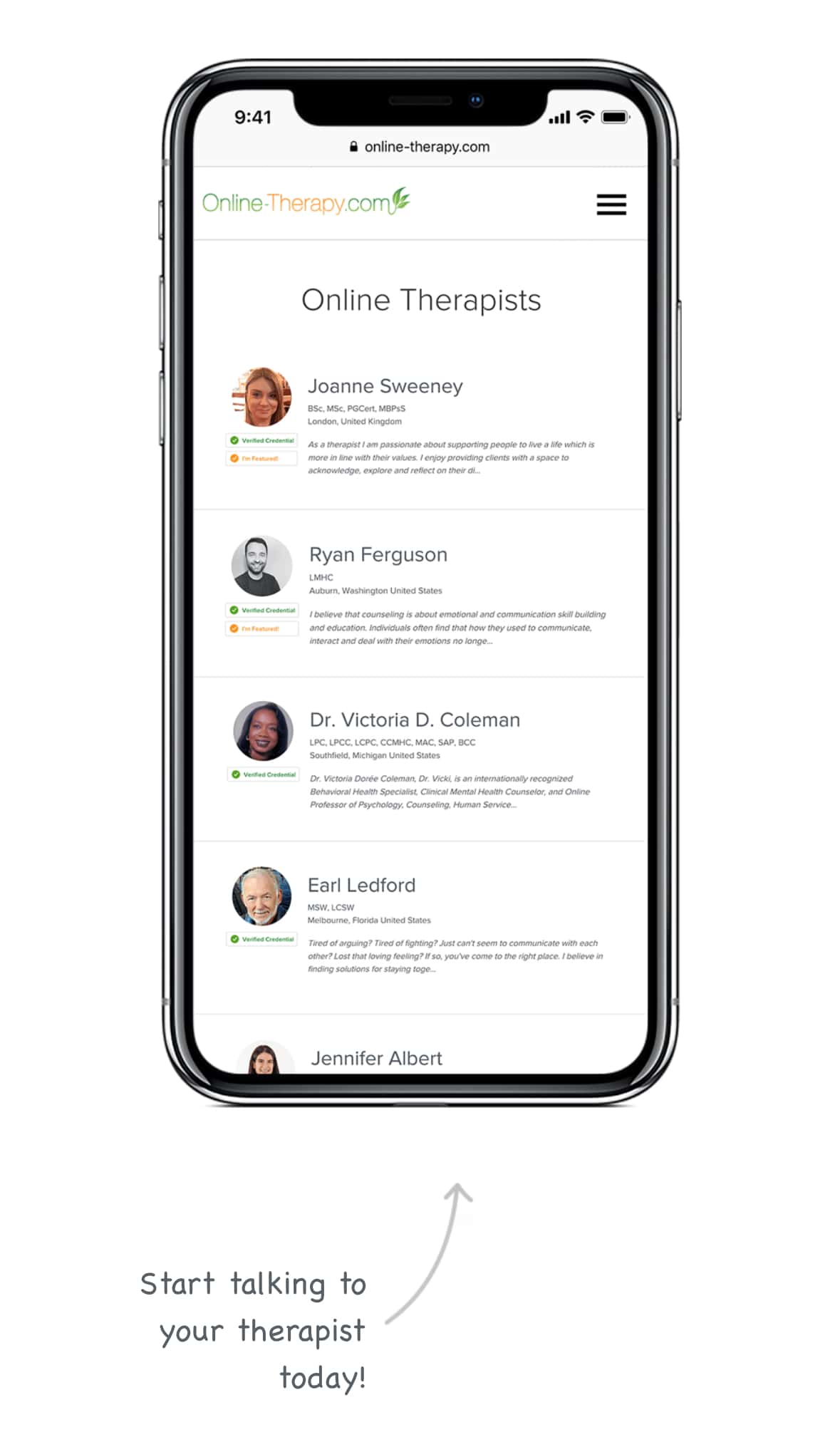Is OCD a form of Anxiety?
Medically Reviewed By – Juliet Gustafson, LMSW

Is OCD a form of Anxiety? Is a question asked by many. OCD and Anxiety share more similarities than differences, no wonder people get mixed up between them. Over the several past decades, OCD and Anxiety were studied throughly by scientists and psychologists. What was discovered was astonishing, changing the perception of both mental diseases respectively.
This post answers the common question of “Is OCD a form of Anxiety?”

🎁 Special Offer: 🎁 When you use our affiliate link, you’ll receive an exclusive 20% discount on Online-Therapy.com services!
Don’t miss this opportunity to invest in yourself and unlock your full potential. Start your journey to mental wellness today!
Say yes to a brighter, happier future with Online-Therapy.com!
20% discount on Online-Therapy.com services
Are you ready to take control of your mental well-being and embark on a journey towards a happier, healthier you? Look no further than Online-Therapy.com!
Experience a transformation in your mental health with the following benefits:
- Convenient & Confidential: Online-Therapy.com provides a safe and private platform for therapy sessions. Say goodbye to the stress of in-person appointments.
- Comprehensive Resources: Access a treasure trove of therapeutic resources, including worksheets, journals, and interactive tools, all designed to help you grow and heal.
- Certified Professionals: Connect with experienced and licensed therapists who are dedicated to your progress and well-being.
- Tailored Approach: Online-Therapy.com offers personalized plans designed to suit your specific needs, ensuring you receive the support you deserve.
What Is Anxiety?
Generalized Anxiety Disorder or (GAD) is a mental disorder causes anxiety and worry. These worries tend to center around multiple areas of one’s life (work, relationships, health, performance).
Excessive worrying is the perfect way to describe GAD. 3% of the US population is diagnosed with Anxiety each year (roughly 6.8 million people). These people suffer from nonstop high levels of worry each and every day.
These worries are about things that are logical in a sense such as health, finances and work. When it comes to actual events, they might worry more than would seem reasonable or they might assume the worst even when there is no evident cause for anxiety. It is noticed that people with generalized anxiety disorder cannot control their stress, but in fact “anxiety” controls them.
Need more on OCD? – Download your FREE OCD Worksheets now!
Examples Of Anxiety
There are 2 types of symptoms in Generalized Anxiety Patients, mental and physical.
Mental Anxiety –
- Unrealistic thought patterns
- Bizarre views on problems
- Concentrating difficulty
- Creating false imaginary scenarios
Physical Anxiety –
- Headaches
- Fatigue
- difficulty sleeping
- either tension or pain in the muscles
- feeling shaky and jittery
- being uneasy or easily startled
- Sweating
- Nausea
- Excessive urinating
How Is Generalized Anxiety Disorder diagnosed?
The Diagnostic and Statistical Manual of Mental Disorders’ criteria are used by medical personnel and mental health specialists to make the diagnosis of generalized anxiety disorder.
Related Article(s) – What are the Similarities and Differences between OCD and Autism?
Criteria used to diagnose patients with GAD
- Extreme levels of worry and uneasiness for a minimum of 6 months
- Have little to no control over their worries
- Such worrisome downgrades everyday quality of life
- Anxiety derails everyday activities such as work
- The direct cause of fear and worrisome is mental, not physical
- Symptoms mentioned above for a minimum period of 6 months
What Causes Generalized Anxiety Disorder?
Scientists, psychologists and psychiatrists aren’t sure about the direct cause of generalized anxiety disorder. However, they believe it’s a mixture of several factors such as genetic, biological and environmental factors.
How Common is Generalized Anxiety Disorder?
As mentioned above, 6.8 million people are diagnosed with GAD on a yearly basis. NAMI, the National Alliance on Mental Illness, estimates that 40 million adults in the United States suffer from an anxiety disorder. This number (40 million) is the sum of people who have some sort of anxiety, not GAD specifically. For many people, symptoms begin to develop before they are 21-years- old.
As of 2022, Generalized Anxiety Disorder is the most common cause of workplace disability in the United States alone. There are also gender differences when it comes to anxiety, for instance women are twice as likely as men to have an anxiety disorder in their lifetime.
The median age of onset for generalized anxiety disorder (GAD) is 31 years old, and approximately 4% of people worldwide may suffer it at some point in their lives.
Related Article(s) – Is OCD a Form of Depression?
Treatment Methods Of Generalized Anxiety Disorders
Generalized Anxiety Disorder (GAD) is a mental health condition characterized by excessive and persistent worry and anxiety about various aspects of life, such as work, health, family, and daily activities. Treatment for GAD typically involves a combination of therapy, medication, and self-help strategies.
Here are some common treatment methods for Generalized Anxiety Disorder:
Cognitive-Behavioral Therapy (CBT)
CBT is a widely used and effective form of therapy for GAD. It focuses on identifying and changing negative thought patterns and beliefs that contribute to anxiety. CBT also helps individuals develop coping strategies and problem-solving skills to manage their anxiety.
Medication
In some cases, medication may be prescribed to help manage the symptoms of GAD. Commonly prescribed medications include selective serotonin reuptake inhibitors (SSRIs), serotonin-norepinephrine reuptake inhibitors (SNRIs), and benzodiazepines. These medications work by balancing brain chemistry and reducing anxiety symptoms. Medication should be prescribed and monitored by a qualified healthcare professional.
Relaxation Techniques
Learning and practicing relaxation techniques can be helpful in managing anxiety. Deep breathing exercises, progressive muscle relaxation, meditation, and mindfulness techniques can help reduce anxiety symptoms and promote a sense of calmness.
Lifestyle Modifications
Making certain lifestyle changes can contribute to better management of GAD. Regular exercise, a balanced diet, adequate sleep, and minimizing the use of substances like caffeine and alcohol can help reduce anxiety symptoms.
Stress Management
GAD is often exacerbated by stress. Learning effective stress management techniques, such as time management, setting realistic goals, and prioritizing self-care, can help individuals cope better with anxiety triggers.
Support Groups
Joining support groups or engaging in group therapy sessions can provide individuals with GAD a sense of community and understanding. Sharing experiences with others who have similar struggles can be comforting and provide valuable insights and coping strategies.
Self-Help Strategies
Engaging in self-help strategies can complement professional treatment. This may include practicing self-care activities, such as engaging in hobbies, journaling, and maintaining a support network of family and friends. Self-help books and online resources on anxiety management can also be beneficial.
It’s important to note that the treatment approach for GAD may vary depending on individual circumstances and preferences. It’s recommended to consult with a mental health professional who can provide a personalized treatment plan based on your specific needs.

What Is OCD?
Obsessive Compulsive Disorder (OCD) is a mental illness that can afflict people of any age, from young children to elderly people. When a person engages in a cycle of obsessions and compulsions, OCD develops.
Obsessions are unwanted ideas, drives, or behaviors that cause incredibly distressing emotions. Compulsions are actions someone takes in an effort to suppress their obsessions and/or lessen their distress.
What Causes OCD?
The exact cause of Obsessive-Compulsive Disorder (OCD) is not fully understood. However, research suggests that a combination of genetic, neurological, and environmental factors contribute to the development of OCD. Here are some key factors that are believed to play a role in the development of OCD:
Genetics
OCD tends to run in families, indicating a genetic component. Studies have shown that individuals with a first-degree relative (such as a parent or sibling) who has OCD are at a higher risk of developing the disorder themselves. However, specific genes associated with OCD have not yet been definitively identified.
Brain Chemistry and Neurological Factors
Imbalances in certain brain chemicals (neurotransmitters), particularly serotonin, have been implicated in OCD. Serotonin is involved in regulating mood, anxiety, and impulses. Abnormalities in the communication between different brain regions, such as the orbitofrontal cortex, anterior cingulate cortex, and basal ganglia, are also observed in individuals with OCD.
Environmental Factors
Certain environmental factors may contribute to the development or exacerbation of OCD symptoms. Traumatic events, such as abuse, neglect, or significant life stressors, may trigger the onset of OCD symptoms in some individuals. Additionally, certain infections, such as streptococcal infections (associated with pediatric autoimmune neuropsychiatric disorders known as PANDAS), have been linked to the development of OCD symptoms in some cases.
Cognitive Factors
Cognitive factors, such as maladaptive beliefs and thought patterns, can contribute to the development and maintenance of OCD symptoms. Individuals with OCD often have intrusive, distressing thoughts (obsessions) and engage in repetitive behaviors (compulsions) as a way to alleviate anxiety or prevent perceived harm. These thought patterns and behaviors can become ingrained and reinforce the cycle of OCD.
It’s important to note that while these factors may contribute to the development of OCD, they do not guarantee that someone will develop the disorder. OCD is a complex condition, and further research is still needed to fully understand its causes. If you or someone you know is experiencing symptoms of OCD, it’s advisable to seek help from a mental health professional for an accurate diagnosis and appropriate treatment.
Related article(s) – 4 Fundamental Causes Of OCD
How Common Is Obsessive – Compulsive Disorder
Obsessive – Compulsive Disorder is quite common among the general public. According to the Anxiety and Depression Association Of America, OCD affects 2.3% of people, or roughly 1 in 40 adults and 1 in 100 children in the United States. Furthermore, According to a 1992 research, approximately two-thirds of OCD sufferers experienced severe symptoms before the age of 25.
Obsessive-Compulsive Disorder (OCD) is a relatively common mental health condition. According to the Diagnostic and Statistical Manual of Mental Disorders (DSM-5), the prevalence of OCD in the general population is estimated to be around 1-2%. This means that approximately 1 to 2 out of every 100 individuals may experience OCD at some point in their lives.
OCD can affect people of all ages, including children, adolescents, and adults. It often begins in childhood or adolescence, but it can also start in adulthood. The severity of symptoms can vary widely, ranging from mild to severe.
It’s worth noting that OCD can be a chronic condition if left untreated, and it can significantly impact a person’s daily functioning, relationships, and overall quality of life. However, with appropriate treatment and support, many individuals with OCD can effectively manage their symptoms and lead fulfilling lives.
Treatment Methods Of OCD
The treatment of Obsessive-Compulsive Disorder (OCD) typically involves a combination of therapy, medication, and self-help strategies. Here are some common treatment methods used for OCD:
Cognitive-Behavioral Therapy (CBT)
CBT is considered the most effective form of therapy for OCD. One specific type of CBT called Exposure and Response Prevention (ERP) is often used. ERP involves exposing the individual to their obsessions (thoughts, images, or situations that trigger anxiety) and preventing the accompanying compulsive behaviors.
Through repeated exposures, individuals learn to tolerate the anxiety without resorting to their compulsions. CBT also helps individuals challenge and modify their obsessive thoughts and develop healthier coping strategies.
Medication
Selective serotonin reuptake inhibitors (SSRIs), such as fluoxetine, sertraline, and fluvoxamine, are commonly prescribed medications for OCD. These medications work by increasing serotonin levels in the brain and can help reduce OCD symptoms. Sometimes, other types of antidepressants or antianxiety medications may be used in combination with SSRIs.
Deep Brain Stimulation (DBS)
In severe cases of OCD that do not respond to other treatments, deep brain stimulation may be considered. DBS involves surgically implanting electrodes in specific areas of the brain to modulate abnormal neural activity and reduce OCD symptoms. It is generally reserved for individuals who have not experienced relief from other treatment methods.
Support Groups
Joining support groups or participating in group therapy can provide individuals with OCD a sense of community and understanding. Sharing experiences and learning from others who have similar struggles can be helpful in managing OCD symptoms.
Lifestyle Modifications
Engaging in self-help strategies and making lifestyle modifications can complement professional treatment. This may include stress management techniques, regular exercise, maintaining a balanced diet, practicing relaxation techniques, and ensuring adequate sleep.
Psychoeducation and Self-Help Resources
Learning about OCD, its symptoms, and treatment options can be empowering. Psychoeducation helps individuals understand their condition and develop insight into their thoughts and behaviors.
Self-help resources, such as books, online resources, and mobile applications specific to OCD, can provide additional support and strategies for managing symptoms.
It’s important to remember that treatment for OCD should be tailored to the individual’s specific needs and may require a trial-and-error process to find the most effective approach. It is recommended to work closely with a mental health professional, such as a psychiatrist or psychologist, who specializes in treating OCD to develop a comprehensive treatment plan.
Related Article(s) – Three Evidence-Based Treatments For OCD
Relationship Between Anxiety And OCD
One might easily get confused between OCD and Anxiety and rightfully so. Hence, the frequently asked question of Is OCD a form of anxiety? They both have recurring thoughts that cause great stress and discomfort.
Both OCD and GAD patients have little to no control over the intrusive thoughts they experience. Furthermore, both share several factors that are believed to cause the onset of each respective disease.
OCD and GAD are among the most common mental illnesses diagnosed among the general public. If you were to add up patients of OCD and GAD worldwide, you will be astonished by the amount of people suffering daily.
422 Million people worldwide suffer from OCD (158 million) and GAD (264 million) , estimated to roughly 4% of the entire world population!
Differences Between Anxiety And OCD
| Anxiety | OCD | |
| Intrusive Thoughts | Excessive worry regarding real life events | Fear of logical (to an extent) and illogical scenarios (Can be real life related as well) |
| Behaviours | No compulsions are present | Actions taken to stop imaginary events from occurring (Compulsions) More stringent measures taken to reduce stress |
| Avoidance | Avoid topics that may trigger fear and worrisome | Avoiding particular situations that could cause OCD symptoms and phobias |
| Reasoning | Increased worry and excessive fear that may derail life and last a minimum of 6 months | Attempting to avoid and stop dreaded envisioned outcomes and events |

🎁 Special Offer: 🎁 When you use our affiliate link, you’ll receive an exclusive 20% discount on Online-Therapy.com services!
Don’t miss this opportunity to invest in yourself and unlock your full potential. Start your journey to mental wellness today!
Say yes to a brighter, happier future with Online-Therapy.com!
20% discount on Online-Therapy.com services
Are you ready to take control of your mental well-being and embark on a journey towards a happier, healthier you? Look no further than Online-Therapy.com!
Experience a transformation in your mental health with the following benefits:
- Convenient & Confidential: Online-Therapy.com provides a safe and private platform for therapy sessions. Say goodbye to the stress of in-person appointments.
- Comprehensive Resources: Access a treasure trove of therapeutic resources, including worksheets, journals, and interactive tools, all designed to help you grow and heal.
- Certified Professionals: Connect with experienced and licensed therapists who are dedicated to your progress and well-being.
- Tailored Approach: Online-Therapy.com offers personalized plans designed to suit your specific needs, ensuring you receive the support you deserve.
Is OCD A Form Of Depression?
In conclusion, Obsessive-Compulsive Disorder (OCD) is considered a form of anxiety disorder. While anxiety disorders encompass a range of conditions characterized by excessive and persistent fear or worry, OCD is distinct in its specific symptomatology.
OCD involves the presence of obsessions, which are intrusive and distressing thoughts, images, or urges, and compulsions, which are repetitive behaviors or mental acts performed to reduce anxiety or prevent perceived harm. These obsessions and compulsions are anxiety-driven and can significantly impair daily functioning and quality of life.
Although OCD is classified as an anxiety disorder, it is important to note that not all anxiety disorders are OCD. Other types of anxiety disorders, such as generalized anxiety disorder (GAD), panic disorder, social anxiety disorder (SAD), and specific phobias, have their own distinct features and diagnostic criteria. OCD stands out due to its unique cycle of obsessions and compulsions.
Understanding that OCD is a form of anxiety disorder can help guide appropriate treatment approaches. Therapeutic interventions, such as Cognitive-Behavioral Therapy (CBT) and exposure and response prevention (ERP), are designed to target the anxiety underlying OCD symptoms and help individuals develop healthier coping strategies. Additionally, medication, support groups, and self-help strategies can all play a role in managing OCD symptoms within the broader context of anxiety disorders.
Ultimately, recognizing OCD as a form of anxiety disorder highlights the need for accurate diagnosis, specialized treatment, and support for individuals living with this challenging condition. By addressing the anxiety at the core of OCD, it is possible to enhance the well-being and functioning of individuals affected by this disorder.
This post answered the question of “Is OCD a form of Anxiety?”


